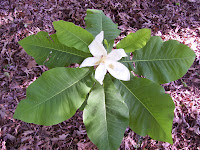
Each year at the beginning of spring, I eagerly anticipate the blooming of our native azaleas. Available in a rainbow of colors--pink, yellow, orange, white, or red, these plants are superior to any other plant, in my opinion. A member of the Rhododendron family, native azaleas are deciduous, and some varieties bloom before leafing out in very early spring. Most of the American native azaleas are fragrant too, with a very pleasant but not overpowering honeysuckle scent. Another important feature is that most of the Native Azaleas are drought tolerant, once established. ('Once established' is the key though, since no plant is established the first year!)
The first to bloom in my garden is the elegant Florida Flame Azalea, Rhododendron Austrinum. Drought tolerant, once established, this plant really lives up to its common name, because the blooms can be any shade of yellow or orange, or even a little of both--yes, the colors of a flame! As the name 'Florida' implies, the Florida Azalea is well able to tolerate any heat our Georgia climate can dish out.
Blooming at about the same time is our own native, the Piedmont Azalea, Rhododendron canescens. Beautiful pink blooms in late March or early April are exquisite.
If you love Alabama like I do, you'll love the very rare Alabama Azalea, Rhododendron Alabamense, with its lovely white blooms coming a little later in spring. This plant is native to East Alabama, and is rarely seen in the wild anymore due to land development in that area. We're fortunate to have a local grower with a love for native plants to propagate this delightful shrub. If you find it in the wild, please don't try to dig it up to move to your own garden. Several varieties of the native azaleas are endangered plants, making it illegal to remove them from the wild.
Most native azaleas do not root easily, so they must be grown from seed! I admire the well-known Mr. Ernest Koone for having the patience to grow these beauties, because I do believe it's important to preserve our native plants.
The native azaleas are becoming more and more difficult to find in nurseries, but can be purchased through mailorder. For more information on the different varieties currently available, check back regularly to read updated profiles of native azaleas with their bloom times and unique characteristics.
To purchase some of these rare plants, go to Shady Gardens Nursery.
